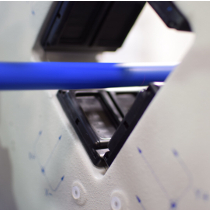For many critical applications, it is essential that plastic tubing is produced within strict dimensional tolerance limits. Spatial measurements of a tube, such as inside diameter (ID), outside diameter (OD), wall thickness, concentricity, and overall length all play separate roles in ensuring a tube performs up to intended standards. For example, Peristaltic-pump tubing is especially susceptible to performance flaws when tubing is manufactured out of specification.
The following are three common instruments employed for measuring tubing dimensions: pin gauges, comparators, and ultrasound/ laser systems.
Pin Gauges
Pin gauges are metal pins of strictly calibrated diameter. When measuring a tube with pin gauges, the pin with the lower limit diameter should fit effortlessly through the inside diameter of the tubing, while that of the upper limit should not. Pin gauges are inferior as a sole means of dimensional analysis as they can not be used for continuous in-process control nor do they imply any information about a tubes outside diameter or concentricity. Samples need to be taken, and statistical methods are employed to determine the likelihood that the ID of a particular length of tubing will be within specification. Pin gauges are better utilized as a tool for post-manufacturing quality control.
Comparators
Optical comparators display an enlarged shadow image of the tubing on a display screen. The tubing is placed in a fixed position in the comparator, illuminated with light sources, and the image projected onto a display. Computer software is used to convert the coordinates of the tubing on the screen to measurements of the internal and external diameter, etc.. Comparators are not normally used on the factory floor, but are useful instruments for examining samples in the QC laboratory. Again, statistical methods are needed to determine the probability that a particular length of tubing will be within specification..
Ultrasound/ Laser Measurement Systems
A laser , such as the technology utilized by TBL Performance Plastics, allows for continuous “real time” measurement of extruded tubing as it is produced. The instrument will continuously measure and record the ID, OD, wall thickness, and concentricity, with high accuracy to ensure all critical dimensions remain within specification. In practice, the sensor output can be fed directly to the servo drive motors in the extruder, so any deviations can be immediately corrected.
Typically, a laser system consists of a controller linked to the following devices:
- “UltraScan” Gauge – This gauge uses ultrasound to determine the wall thickness and concentricity of the extruded tubing. The ultrasound is reflected from the inner and outer tube surfaces.
- “LaserSpeed” Detector: This is a non-contact unit, which measures the speed of the extruded tubing using lasers, from which the length produced can be calculated.
Data from the whole of the production run can be collected, and retained for subsequent audit if necessary.
Conclusions
Continuous laser measurement devices are superior to pin gauges or comparators as an in-process measurement device. However, pin gauges and comparators are valuable quality-control tools for carrying out a final check of the tubing dimensions, and to analyze which materials have a tendency to expand or shrink after they are allowed to set over time. A robust quality control system will utilize several of such methods to ensure that tubing is manufactured consistently and within specification.

